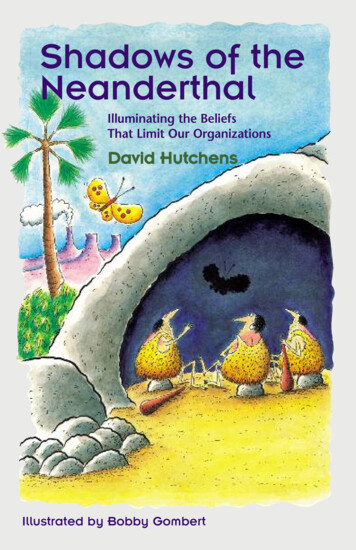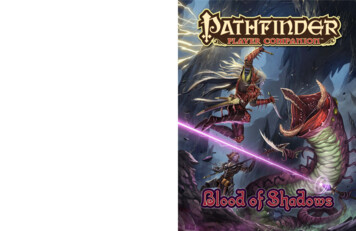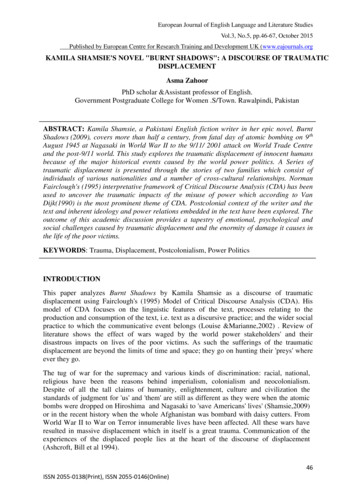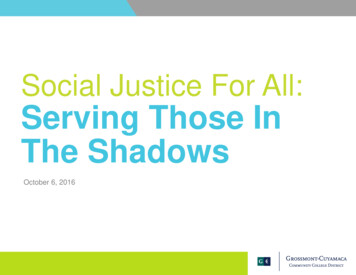
Transcription
Shadows of theNeanderthalIlluminating the BeliefsThat Limit Our OrganizationsDavid HutchensIllustrated by Bobby Gombert
Shadows ofthe NeanderthalIlluminating the BeliefsThat Limit Our Organizationsby David Hutchensillustrated by Bobby GombertPEGASUS COMMUNICATIONS, INC.Waltham
Shadows of the Neanderthal:Illuminating the Beliefs That Limit Our Organizationsby David Hutchens; illustrated by Bobby GombertCopyright 1999 by David HutchensIllustrations Pegasus Communications, Inc.All rights reserved. No part of this book may be reproduced or transmittedin any form or by any means, electronic or mechanical, includingphotocopying and recording, or by any information storage or retrievalsystem, without written permission from the publisher.Library of Congress Cataloging-in-Publication DataHutchens, David, 1967–Shadows of the Neanderthal: illuminating the beliefs that limit our organizations /by David Hutchens ; illustrated by Bobby Gombert. –1st ed.p.cm.ISBN 1-883823-30-71. Creative ability in business. 2. Business communication. 3. Organizational learning.2. I. TitleHD53.S48 1998658.4—DC2198-34524CIPAcquiring editor: Kellie Wardman O’ReillyProject editor: Lauren JohnsonProduction: Julie QuinnPrinted in the United States of America.First editionPegasus Communications, Inc. is dedicated to providing resources that help peopleexplore, understand, articulate, and address the challenges they face in managingthe complexities of a changing world. Since 1989, Pegasus has worked to build acommunity of systems thinking and organizational development practitionersthrough newsletters, books, audio and video tapes, and its annualSystems Thinking in Action Conference and other events.For more information, contact us at:One Moody StreetWaltham, MA 02453-5339Phone: (800) 272-0945 / (781) 398-9700 Fax: (781) 894-7175Email: customerservice@pegasuscom.com / info@pegasuscom.comwww.pegasuscom.com
COPYRIGHT REMINDERSPlease respect the copyright laws regarding use of thise-book.You CAN print a copy of the e-book for your own use.You CAN loan your personal printed copy to anotherperson, just as you would a regular book.You CAN make the e-book available to multiple peoplewithin your organization by purchasing a site license.Contact sitelicense@pegasuscom.com.You CANNOT print multiple copies and distributethem to others.You CANNOT give a copy of your PDF to anotherindividual or organization.Forwarding this PDF is strictly prohibited.iii
Chapter 1:In Which the CavePeople PonderTheir Existence
Once upon a time, there were five cave people.Their names wereUnga, Bunga,Oogie, Boogie,and Trevor.They lived together in a cave.2
In fact, the cave people never left the cave. Theyjust stayed there, day in and day out, waiting fordead bugs and dried leaves to blow in so thatthey might have something to eat.The cave people embraced this isolated lifestyle.That’s because they believed that the mouth of thecave was the edge of the universe.This situation produced some interesting existentialreflections among the cave people.3
“Outside of cave isnothing. Go outsideand poof—no moreUnga,” preached Unga.“No, outside is bigdragon. Dragonswallow Bungawhole,” counteredBunga.“No, no, no,” said Oogie.“Outside is big mad god.Big mad god stomp onOogie, and splat. Biggross mess.”4
Despite their theological differences, the cave peoplewere united on this one point: They must neverleave the cave.In fact, just to be safe, the cave people never evenfaced the mouth of the cave. They lived their entirelives with their backs turned to the entrance.As you can imagine, life was pretty dull for the smallclan. And their backs were always sunburned.5
Sometimes, an animal would pass by the front ofthe cave. But the cave people would never see it.Instead, with their backs turned, they would onlysee the animal’s shadow projected onto the cave’sback wall.To the cave people, these shadows were reality.6
Thus, if a hyena came leaping by the mouth of thecave, the cave people would cower from its shadowon the back wall.Or if a butterfly drifted by, they would leap up indelight and chase its delicate, fluttering shadow.7
Once, a crazed giraffe stomped a warthog to deathjust outside the cave.Nobody could figure out what the heck that was.8
The cave people never realized how limitedtheir understanding of the world was.For them, it was just truth.And they were satisfied.9
Chapter 2:In Which BoogieAsks a QuestionThat Freaks OutEveryone Else
Every year as springtime rolled around, the cavepeople looked forward to another long, productiveseason in the cave, painting stick figures on the walls,eating dead bugs, and sculpting ashtrays out of clay.(Yes, ashtrays. The evolving race had yet to masterthe art of pottery. Thus, despite their best efforts,everything they made came out looking likean ashtray.)Yet on one soft Spring morning, Boogie woke upfeeling restless.“Boogie bored and hungry,” he said, chewing adried magnolia leaf that had blown into the cave.Looking around the same old drab walls of the cave,he casually mused, “Boogie wonder what is outsidecave.”12
The others stared at Boogie in shocked disbelief.No one had ever said such a thing before.Boogie tried to explain: “Boogie just wonder ifmaybe more food outside. Or maybe more water.Or more room.”“What Boogie talking about?” asked Unga,incredulous.“Plenty room here!” snapped Bunga.“And plenty food,” added Trevor, sucking on a rock.“But we only see what inside cave,” Boogie said.13
“What if we not see what really is?”14
This question was very disturbing to the other cavepeople. They began to get angry.“Boogie saying we wrong!” cried Unga.“Boogie lost mind!” said Bunga.“Boogie delusional and narcissistic,” concludedTrevor, who often soothed his own insecurities bylabeling others with sweeping psychotherapeuticgeneralities.“Boogie want to ruin everything!” accused Oogie.“This could be end of us!”15
“If Boogie so curious,” snarled Unga, “then Boogiecan just get out of cave! Go out into nothing andgo poof!”“Let mad god squish you like bug!” hissed Oogie.“Go out and get breathed on by dragon’s badbreath!” yelled Bunga.Trevor picked up a clay ashtray from the ground andthrew it at Boogie. The others joined in, bombardingthe shocked little cave man.“Yes, go!” they chanted. “Get out!”16
Covering his head and cowering from the bruisingobjects and stinging words being hurled at him,Boogie turned and faced the mouth of the cave forthe first time in his life.“Go!” the others yelled.Choking back his tears, Boogie ran away from hisfriends, toward the mouth of the cave 17
and out into the bright lightof the world outside.18
Chapter 3:In Which Boogie’sEyes Are Openedto the World
Dazed from the shocking attack from the othercave people, Boogie stumbled about outsidethe cave until he collapsed, exhausted.For a long time, he just lay there, crying andconfused.Why had his clan turned on him so suddenly andsavagely? All he had done was ask some questionswhich, to him, seemed pretty simple and legitimate.20
Finally wiping the tears from his eyes, Boogielooked up.He gasped.21
22
23
This outside world was big—bigger than Boogiecould ever have imagined.He saw creatures, amazing and diverse. Some hevaguely recognized from the shadows he had seen inthe cave, but their shadows had only hinted at theirtrue beauty.In awe, Boogie began to explore.24
25
Boogie had been walking and exploring for a longtime when, in the distance, he saw what appearedto be a man sitting on the side of a hill.As he got closer, he could see that it was indeed aman—a very, very old man.26
“Hello. My name Boogie,” Boogie said, approachingthe man.“And I am The Seer of Truth and Purveyor of WisdomWho Sits on the Mountainside,” the man said. “OrMike, if you prefer. Please, sit.”Boogie seated himself next to Mike.“I see that you have come from a cave,” Mike said.“Welcome to the outside world. You are the first tocome out. Did you bring others with you?”“No. Boogie alone. How you know Boogie comefrom cave?”“Your grammar is atrocious,” the Purveyor ofWisdom said. “Why don’t cave people ever use theirarticles and pronouns? It makes me so crazy.”27
Boogie blushed, but Mike continued: “I have beenwaiting for the day when all cave people wouldagain emerge from their caves and repopulate theland.”Boogie was amazed. “Other cave people are livingin other caves?” he asked. (He worded his thoughtscarefully, for he was now self-conscious aboutconjugating his verbs.)“Oh, yes. There are many, many others, living inhundreds of caves, all across this land,” Mike said,staring off sadly into the distance. “They nevercome out. They never learn.”28
“Why so many choose to live in cave, when world isso much bigger out here?” asked Boogie.Settling in, Mike answered:“It all began long ago. ”29
Chapter 4:In Which MikeTells the Tale ofTwo Tribes
“It started around forty-five minutes into theNeolithic period,” Mike said. “Your ancestorsall lived together in a large tribe, right here in thesefields. Their numbers grew every year. These werehappy times.“But as the numbers increased, these fields could nolonger support the people. Food became scarce, andthe people went hungry. They realized they wouldhave to branch out if they were to survive.32
“The people were desperate. So they came togetherfor a meeting before the elders of the tribe. The wiseelders told them: ‘Go and build tall towers that willallow you to see as much of the surrounding landsas possible. When we learn more about the landsaround us, then we shall know what we must do.’“So that’s what the people did.”33
Mike paused for a deep breath. He continued:“After many, many days, the people returned to theelders.“‘Have you built the towers?’ the elders asked.“‘Yes we have,’ the tribe replied.“‘Have you seen the lands around us?’ the eldersasked.“‘Yes we have,’ the tribe replied.“‘Then what must we do to survive?’34
“‘We must build collecting baskets and storehousesfor food and weaving looms to make tents,’announced one group. ‘Only then will we be able tosurvive in the surrounding lands.’“But then another group spoke up. ‘No, we mustbuild spears, traps, and tools for the hunt. Only thenwill we be able to survive in the surrounding lands.’35
“The first group responded: ‘If we waste timebuilding spears and traps and tools for the hunt, thetribe will surely die.’“The second group said, ‘No, if we waste timebuilding collecting baskets and storehouses andweaving looms, then the tribe will surely die!’“Now the elders were confused,” Mike said.“Me too,” said Boogie,engrossed. His eyes were wide,and he sucked nervously on arock. “What happen next?”“The people got angry, that’swhat happened next.36
“The first group said to the other: ‘Weapons are forkilling. To build weapons is barbaric. You arebarbarians!’“The second group responded: ‘To sit and weavebaskets while our people die of hunger is cowardly.You are cowards!’“And so it went, back and forth:‘Barbarians!’‘Cowards!’‘Violent animals!’‘Tree-hugging dorks!’”Although Boogie didn’t know exactly what a treehugging dork was, Mike’s story evoked painfulmemories of his last moments in the cave. “Evil” and“delusional” were the words his friends had used.37
“So then what happened?” Boogie asked.Mike was quiet for a moment, gazing sadly into thedistance. Finally he spoke.“The tribe split. The first group wove their baskets.The second group built their spears. Eventually thepeople with the spears drove out their fellowtribesmen, who scattered through the hills and hid.Then, those with spears began to argue amongthemselves. In the end, they turned on one another.It was horrible.”38
“So they really were barbarians and cowards,”Boogie observed.“No. At least, not at the beginning. But it’s whatthey became. The labels they placed on each otherbecame reality. Interesting, how that happens, isn’tit?” Mike asked.It certainly was interesting, but Boogie wasn’t quitesure he understood it. He decided he would have tothink about that.39
“So where everybody now?” Boogie asked.“In caves. Everyone lives in caves,” Mike said quietly.For a long time, Boogie and Mike just sat there,gazing towards the horizon of that vast, emptylandscape.40
Chapter 5:In Which the Tale ofTwo Tribes Is Explored,Nearly Giving Boogiea Migraine
Boogie’s mind raced as he tried to grasp Mike’sstory of the two tribes. He thought back to hisexperience in his own cave. It somehow seemedrelevant to all of this but he wasn’t sure how. Hewished his pre-evolutionary neo-cortex were moreevolved. Maybe then he could fully understand themeaning of Mike’s story.Finally, Boogie asked: “So, why tribe disagree atbeginning, anyway? Why divide over spears andbaskets? Boogie not understand.”The old man’s eyes sparkled. “Ah. Very goodquestion, Boogie. Let’s go back to the beginning.Why do you think they disagreed?”42
Boogie mulled this over for a few moments.Finally, he replied:“Not sure, but maybe was like shadows on wall.”43
Boogie could tell that the Seer of Truth didn’t quiteunderstand. Boogie continued:“Well,” he said, choosing his words carefully, “maybeeveryone see world wrong—like seeing shadows. Wesee wrong, so we act wrong.”“Very good, Boogie,” said Mike. “But perhaps it’snot a matter of seeing wrong, but of seeingincompletely. And that’s what happened with ourancestors. Follow me and I’ll show you.”44
Boogie and Mike walked several miles to the far eastside of the field. There, they came upon one of theold towers their forefathers had built so many yearsago. It was weathered and ramshackle, but stillstanding.“Go up and see,” said Mike.Carefully, Boogie climbed the crumbling stone stairsthat spiraled to the top of the tower.45
From the top of the tower, Boogie could see theeastern horizon. It was coarse, rocky land, populatedwith buffalo, elk, and sheep.Boogie could see how, in a land this rich withwildlife, you would certainly need spears, traps,and tools for hunting.46
His brow furrowed, Boogie descended the tower andrejoined Mike. “Follow me,” Mike said again.They walked several more miles in the oppositedirection. They came upon another crumbling,weathered tower—this one looking out to the west.Boogie climbed the tower.47
From the top of the tower, Boogie could see thewestern horizon. Unlike the eastern landscape, thiswas lush land, covered with grape vines, corn stalks,and wild cotton bushes.Boogie could see how, in a land this rich withvegetation, you would certainly need baskets andstorehouses and weaving looms.48
Now Boogie understood why the two tribes wentto war. Two different towers; two different views.“We only see in part. ” he whispered to himself.He stood there, deep in thought, for a long time.49
Finally, Boogie emerged from the base of the tower.He seemed frustrated.“It all seem so silly,” he said to Mike. “Why divide?Why fight over different views? Why not just go ineach other’s towers, so everyone understand howother sees different?”“It does seem pretty simple, doesn’t it?” answeredMike. “But it seldom works that way. Instead, peopledivide and work against each other. Why do youthink this happens?”Boogie wasn’t sure. But it did appear that peoplebecame awfully upset when asked about theirbeliefs, or when somebody suggested there mightbe other ways to look at things. Soon came thelabels like mad, or barbarians, or cowards. Andafter that, came the bruising ashtrays and murderousspears.Boogie decided this was another important thing tothink about.50
Suddenly, Boogie turned from Mike.“Boogie go back now,” Boogie said.“Where are you going?” asked Mike.“Back to cave. Must tell others what I have seen.No more dividing; no more hiding in caves;no more eating cereal made of gravel.“Must give others chance to climb more towers.Must all work together to see more truth. Then wecan be great in number again. We can eat meat,and drink wine, and make shelter, and populate allof this land.”51
“Be careful,” Mike warned him. “Remember howpainful it was for a curious caveperson like you toleave the cave. Imagine how much harder it will befor the others, who are satisfied to stay there.”“Others not be satisfied when I tell them about greatbig world, and show new way to see,” Boogie said,as he turned to leave. “Others will want to learnmore, see more.”“Boogie! Wait !” Mike called after Boogie.But Boogie was already gone.52
Chapter 6:In WhichBoogie Returnsto His Cave
After walking many miles, Boogie approached themouth of his old cave.54
From deep inside the cave, Boogie could hear themuffled voices of Unga, Bunga, Oogie, and Trevor,and the familiar crunching sounds as they snackedon dead locusts. (It suddenly occurred to Boogiehow gross this really was.)Boogie’s heart ached with sadness and fear. Wouldhis friends turn violent as they had once before?Would they attack him for telling them about theshadows, and the great world he had seen outsidethe cave?Or would they be open to joining Boogie inexploring the things they all believed?55
Trembling, Boogie took a deep breath.If they no want to learn, Boogie thought as hestepped into the cave, I find others who will.56
After all, he thought, Mike said there were manyothers, living in hundreds of caves 57
58
but really, there were millions.59
The End
A Closer Look at Shadows of the NeanderthalWait—don’t close the book quite yet.You may be thinking, “Ugh this last part doesn’t look like it’s asmuch fun to read as the first part.” That’s okay. If you wish to skip thisportion of the book and enjoy the story on its own terms, you’rewelcome to do so. Metaphors hold real power when the reader isallowed to discover their meanings at his or her own pace.However, deep learning often works best when it is accompanied byreflection and experimentation. That’s what the following pages are for.This section will facilitate your own reflection as you explore thethemes presented in Shadows of the Neanderthal. So the choice is yours:Feel free to simply enjoy the story “as is,” or dive in deeper for somepersonal exploration.Still reading? Then like Boogie, you have an appetite for deeperunderstanding! This is a path that can lead to richer awareness of ourcomplex human experience. But be forewarned that for the next fewminutes, we’re going to be examining your thinking and exploringthe ways you perceive and interpret your world. As Boogie learned,this can be hard to do. If you come up against any unsettling feelings,stay with them—real learning is just on the other side!Shadows and LightShadows of the Neanderthal is really a story about mental models—a termcoined in the 1940s by Scottish psychologist Kenneth Craik. Here isour definition: “Mental models are the deeply held beliefs, images, andassumptions we hold about ourselves, our world, and our organizations, andhow we fit in them.”This is not abstract, academic stuff. It’s a simple idea, really. Andit’s full of implications for our businesses, our families, our61
churches, our schools, and all other areas in our lives, since wealways need to get along with other people who see thingsdifferently from us.Nor is this a new idea. In his famous dialogue The Republic, the Greekphilosopher Plato tells The Parable of the Cave, in which a group ofsubterranean people mistake the shadows they see in the cave forreality. In Plato’s original telling of the story, when one of the peoplediscovers the truth about the source of the shadows and attempts toshare his knowledge with the others, they rise up and slaughter him.Plato’s conclusion to his story is a chilling one: We are all misguidedcave dwellers, Plato says, operating under incomplete or distortedperceptions of reality and violently resistant to having thoseperceptions challenged.Ouch. This opens the door to some difficult questions—questions like: Hey—what’s so wrong with the way I see the world? Why do so many people reject the truth, when the truth seems soobvious? What does this really have to do with me or my organization, anyway?Let’s answer that last question first. The discussion of this idea isimportant because mental models limit our organizations every day.Organizational case studies abound of good ideas that never got offthe ground, simply because they didn’t match the prevailingassumptions or beliefs. One popular illustration is of the Swiss watchindustry, which dominated the world market for watches for manyyears. When the new quartz technology was first introduced, theSwiss manufacturers rejected it, since it didn’t match their mentalmodel that watches should be mechanical, “ticking” devices—ratherthan high-tech ones. Instead, Japanese manufacturers like Seikoadopted the new technology, and rapidly took much of the worldmarket from the Swiss. The Swiss fall in the global watch market canbe traced back to their dependence on their mental models aboutwhat made watches desirable.62
Perhaps you have experienced highly politicized conflicts in yourorganization—conflicts in which people are polarized into factions,each one claiming that the other is short-sighted or self-serving. Lookinto the heart of such conflicts, and you’ll often find different sets ofassumptions at work.Even in religious movements that strive for unity and love, peopleoften find the gulf of separation between themselves and othersbecoming wider and wider. (Ironically, history is rife with waratrocities that have been committed in the interest of divine love.)These same dynamics may be observed in our families. Again, ourmental models are key culprits in such conundrums.Let’s take a closer look at our mental models, and the power thatthey hold.Seeing, Believing, and Mental ModelsSo, what is a mental model, really? And how does it function? Hereare seven principles that can help illuminate the concept:Principle # 1: Everyone has mental models.You have mental models about how the world works. It is impossiblenot to have mental models. As cognitive theorist Edward DeBonoillustrates, your mental models are the result of a physiologicalprocess in which the neural networks of your brain work tocategorize and organize the endless stream of complex informationyou take in every day. If your mind didn’t perform this function, youwould be confused every time you saw a car of a different make andstyle. But fortunately, your mind is efficient enough to say, “Oh,look—there are wheels, windows, headlights that must fall into thebrain category labeled ‘car’!” Remember that a mental model isneither a good nor a bad thing—it’s just your brain’s way of creatingorder out of this complicated world. The trouble occurs when ourbrains do their job too well, and we force-fit everything we see intocategories that worked for us in the past.63
Note that individuals aren’t the only ones with mental models. Whenindividuals are organized together, the groups and organizations theyform also develop mental models. Organizations, families,governments they are all governed by the collective, deeply heldbeliefs and assumptions of individuals. In the United States, onecollective mental model that is a basis for the very society is the rightto “the pursuit of happiness.” Virtually all Americans feel entitled tohappiness, because they think of it as an “unalienable right.” Fewhave ever thought to challenge the truth of this statement. This is amental model that has real impact on Americans’ daily lives, drivingmany careers, relationships, and even lawsuits. (Note that there arenumerous societies where this expectation of happiness isn’t part ofthe collective mental model.)Principle # 2: Mental models determine how and what we see.Our perceptions aren’t as clear as we’d like to believe. Everything weperceive must first pass through our filters of mental models. And ifsomething doesn’t match the “road map” in our head, we may simplybecome blind to it.One colleague conducts this exercise in Western culture trainingprograms: She asks participants in the classroom to study her faceand describe her facial features. Typically, participants will describeher nose, hair, eyes, lips, etc. But after conducting this exercisecountless times, not one participant has ever mentioned the littledivot-shape area between her nose and upper lip. In the West, there isno commonly used word for that part of our faces and as a result,people simply don’t see it. (When was the last time you noticed thisfeature on your spouse’s or best friend’s face?)I recently saw a photograph of a densely populated downtown streetin the city of Hong Kong. Because I am an American, most of theinformation in the picture appeared to me as a confusing jumble ofstreet signs, shop windows, and neon, all in alien Chinese symbols.However, despite the complexity of the photograph, I noticed howmy eyes were almost instantly drawn to a small sign in the photobearing the familiar McDonald’s golden arches logo. In a world of64
chaotic information, the mind instantly locks onto that which italready knows—and simply filters out other data.It’s a disconcerting thought, but there are truths and richopportunities that are off-limits to us, simply because they do notmatch our mental models. At the end of the Shadows story, wediscover that the cave people are actually living in contemporarytimes. Yet Boogie remained unaware of the cityscape that existed justbeyond his rudimentary cave. (Perhaps it was Boogie’s mentalmodels that had inhibited his own evolution while other parts of theworld progressed!) To some extent, each of us also lives in a cave,blind to a bigger world just outside our radar screen of perception.For your reflection: Think of a comment that a spouse, partner, or colleague has madeabout you that you found disturbing or frustrating. Afterreflecting on the comment, do you find that there is any truth init? How hard was it initially for you to consider that the commentmay be accurate? How is the comment inconsistent with yourown deeply held beliefs about yourself? Have you ever known anyone with behaviors or traits that werevery obvious to others, but seemingly invisible to that person?Why do you think this was so? Might you have similar blind spotsabout yourself, because they don’t match your self-perception?Principle # 3: Mental models guide how we think and act.In the story, Boogie began questioning his own thinking when heasked, “What if we not see what really is?” The initial mental modelheld by the cave people was, “There is no possible existence beyondthis cave.” This affected their thinking, which eventually resulted inthe development of their personal belief systems (like “a big mad godlives outside the cave”). Their mental model also affected their actions:They stayed in the cave without ever leaving, even if it meant eatingbugs and sucking on rocks. For better or worse, our own mentalmodels limit the range of behaviors we tend to take.65
Numerous business case studies illustrate this phenomenon. Forexample, from 1915 to 1955, the only way one could purchase CocaCola (other than at a soda fountain) was in the famous 6 1/2–ounce“contour” bottle that had played such a critical role in the soft drink’searly marketing success. The 6 1/2–ounce contour bottle was treatedas sacred to the brand’s identity, and was widely held to be the “onlyway” to sell Coke. Coke refused to change for many, many years,even as it lost market share to Pepsi. It was only after deep losses thatthe company became open to changing its mental model andexploring the possibility of other packaging (like the 12-ounce size).Likewise, many companies have made history by introducing newmental models. Federal Express and Apple Computer developedproducts and services that many people thought no one would everwant. Dell Computer, too, has changed people’s mental models abouthow computers can be distributed and sold.For your reflection: Think of a time (either personally or organizationally) when youdid not get the results you wanted. What were the actions youtook that led to those results, and what was your thinking at thetime that caused you to take those actions? (It may be easier toreflect on this with a friend, because it is often hard to see ourown mental models.) Think of a time when you or a group you were associated withexcelled by adopting a new mental model.Principle # 4: Mental models lead us to treat our inferences as facts.To Boogie, the warring tribes’ conflict seemed absurd. Surely theycould have avoided war and resolved their differences simply bysaying, “Hey—wait a minute! There are two different towers withtwo different views! We are each looking at different parts of thelandscape, from different perspectives!”But maybe it isn’t so absurd. The metaphor is correct: We rarely reportour conclusions about the “landscape” as our own mental models.Instead, we simply state what we see as if it were fact. In reality, our66
beliefs seem so obvious to us that we are often amazed that others cansee things so differently. Our beliefs remain closed to challenge, andthe mental model stays tacit, or hidden.Imagine a manufacturing plant where there is growing tensionbetween hourly workers and management. Note that a managerprobably would not say, “I have a mental model that the hourlyemployees aren’t very hard workers.” Instead, the manager is morelikely to just say, “The hourly employees aren’t very hard workers.”That’s a big difference. By not acknowledging that his belief is merelyhis own mental model, he makes it difficult for himself and others toexamine that belief. By stating “They aren’t very hard workers” asfact, the manager creates a situation where it is unlikely that anychange will occur.As we shall see, the lifelong challenge of mental models is identifyingthem and bringing them out into the light, where they can no longerexercise thei
Shadows of the Neanderthal Illuminating the Beliefs That Limit Our Organizations . No part of this book may be reproduced or transmitted in any form or by any means, electronic or mechanical, including . You CANNOT give a copy of your PDF to another individual or organization. For











